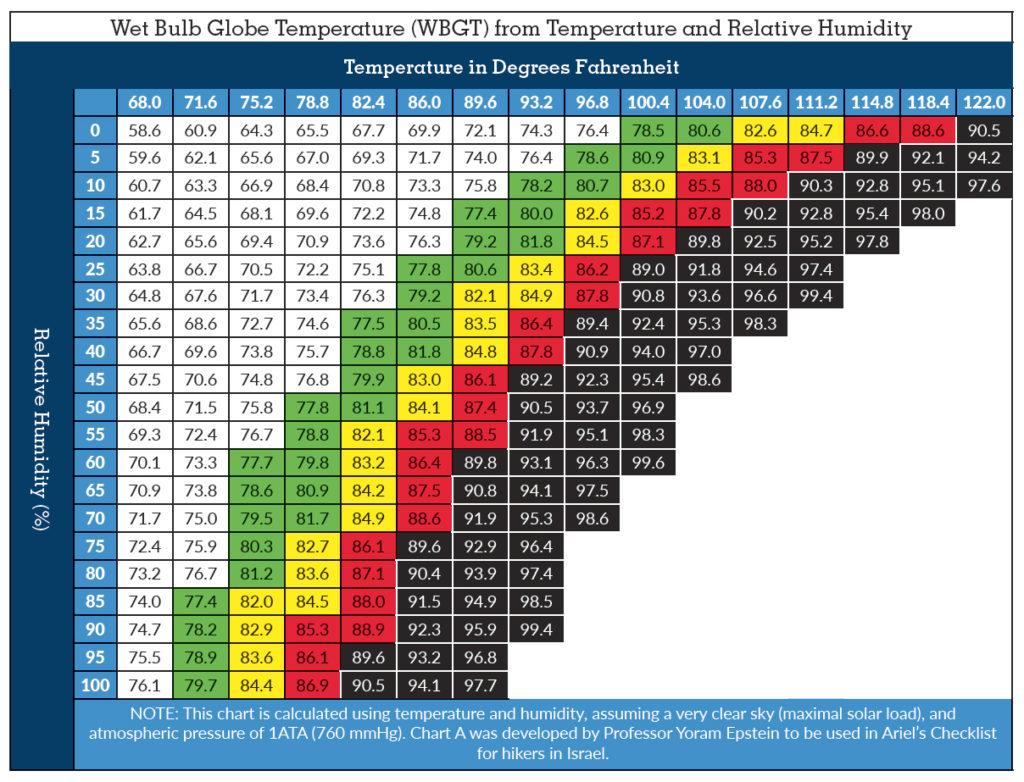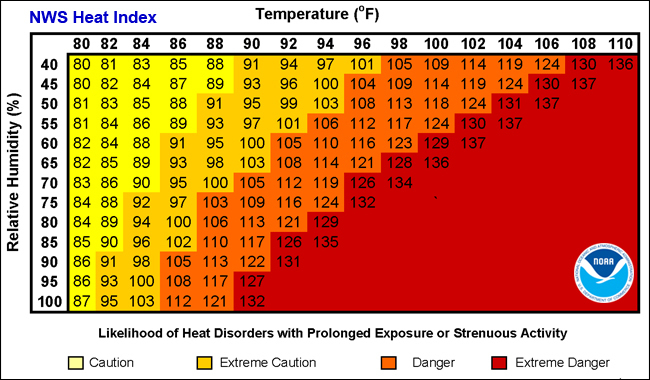The purpose of this section is to educate river users on the challenges of river use in extreme temperature or humidity ranges common in the DC area.
COLD WEATHER CONCERNS
River use in cold weather involves air and water temperatures, as well as wind chill. All three elements need to be considered before launching as the impact on the comfort and safety of an individual. Hypothermia is the biggest danger and can quickly impair an individual. In cold weather, it is strongly advised one consider the effectiveness and safety of practicing on the river. The following should be taken into consideration:
- A safety launch is always advised. When not possible, a partner system should be used so others are available to assist in an emergency.
- Someone should be made aware of your rowing/paddling plan including duration, and general travel path. Clubs are advised to keep a log of launch and landing times for any crew going out.
- Carry a cell phone with you in a waterproof and floating case. Secure it to your boat.
- Carry an emergency whistle that is easy to access and secured to the boat or your person.
- Scullers, paddlers, and coxswains should consider wearing some form of floatation device, be it an inflatable suspender-style PFD, a survival suit, or a wet suit as appropriate. These will offer support in the event of a water immersion situation, but will not necessarily prevent life-threatening hypothermia.
- Any individual who is not adequately prepared for the conditions or suffers a cold water immersion is susceptible to hypothermia and frostbite.
- Individuals who are not actively exercising are at great risk as they are not generating heat on their own (i.e. people “sitting out” in an 8+ or 4+)
- Sweat or wet clothes can contribute to hypothermia, even if the individual is not immersed in cold water.
- All participants should dress in layers, consisting of wool or synthetic fibers, and wear a windproof outer layer.
- Having more layers as necessary, and allowing time for athletes to remove layers, allows for proper heat regulation and limits the amount of sweat trapped against the body which can substantially cool the body.
- In wet conditions individuals should wear waterproof clothing that is also breathable.
- Cotton clothing should be avoided by all users as it offers no protection against the cold when wet.
WIND CHILL
Wind chill increases the impact of cold on the body, and effectively lowers the temperature for the individual. The lower the temperature and the higher the wind speed, the greater the wind chill effect. This is true both for participants, as well as those riding in safety launches. Individuals who are involved in an accidental immersion, who are out in the rain, or athletes who are simply wet from being splashed or from sweat, are even more susceptible to hypothermia through hypothermia.
The following wind chill chart is based on practical rowing temperatures and wind speeds, and is based on NOAA formula and chart which can be found here: https://www.weather.gov/safety/cold-wind-chill-chart
| Practical Wind Chill Chart For Rowing And Paddling | ||||||
| Temperature in Fahrenheit | ||||||
| Wind Speed | 50 | 45 | 40 | 35 | 32 | 30 |
| 5 | 48 | 42 | 36 | 30 | 27 | 24 |
| 10 | 46 | 39 | 33 | 27 | 23 | 21 |
| 15 | 44 | 38 | 31 | 25 | 21 | 19 |
| 20 | 43 | 37 | 30 | 23 | 20 | 17 |
HYPOTHERMIA
Hypothermia is a condition that occurs when the temperature of the human body is lowered to a dangerous point due to exposure to cold and/or wet conditions. Cold temperatures, wet conditions, and wind chill work together to pull heat away from the body, lowering the body’s core temperature. Even in mild conditions, adding rain or submersion in cold water can sufficiently reduce body warmth to trigger hypothermic conditions in the body. A person’s condition can degrade rapidly impairing breathing and coordination making it impossible to swim or keep one’s head above water. Emergency action needs to be taken no matter the level of hypothermia.
Early Hypothermia
- Symptoms: Rapid shivering, numbness, loss of strength and coordination, semi-consciousness.
- Action: Maintain an open airway. Transfer to a warm environment as soon as possible. Remove wet clothing.
- Use blankets to help warm the individual or if available a warm shower. Warm torso area first.
- Seek medical attention.
Profound Hypothermia
- Symptoms: The person will be pale, stiff, and cold. Unresponsive to stimuli, and possibly unconscious. Little or no cardiac or respiratory activity will be present.
- Action: Move or manipulate as gently as possible. Prevent further heat loss, but do not attempt to rewarm. Maintain open airways, and activate EMS procedures.
- Call for emergency help immediately!
HEAT-RELATED CONCERNS
Rowing in hotter temperatures, including the humidity that is present in our area in the summer months can be life-threatening to anyone on the water who does not take adequate precautions. Consider these factors when temperatures rise:
- Everyone handles the heat differently. It also takes time to acclimate to increasing temperatures and humidity.
- Humidity impacts the body’s natural ability to cool itself since the evaporation of sweat is diminished.
- The best way to avoid heat-related injuries is to practice at cooler times of the day: early morning or late afternoon.
- Intake of fluids is key and should be encouraged. Dehydration further impairs the body’s ability to cool off.
- Water is the best fluid for most outings on the river. Sports hydration drinks are useful only after 60-90 minutes of consistent activity. Mild sugar solutions in those drinks, along with electrolytes, encourage the process of hydration, as well as drinking by the individual.
- Light-colored clothing that breathes well is recommended.
- Hats, which can be dunked in the water, offer sun protection for the face and offer a passive cooling effect while moving.
- Unrelated to temperature, but to the time of year of heat-related emergencies, the use of sunscreen should be encouraged. Doing so protects from burns (which do dehydrate the body), but also for long-term protection against skin cancer.
WET BULB TEMPERATURE AND HEAT INDEX
When considering working out in heat and humidity, it is important to consider both together. Rather than looking at only ambient temperatures, one should consider Wet Bulb temperatures, which are the most accurate method for determining the body’s ability to adapt the heat/humidity. The following link goes to a National Weather Service (NWS) map of the area that provides Wet Bulb heat temps. The map offers a risk level of low, elevated, moderate, high, and extreme, which one should use for determining whether to practice, the time of day, and the duration: https://digital.mdl.nws.noaa.gov/?zoom=9&lat=38.76874&lon=-76.96633&layers=FB000TTTFTT®ion=0&element=8&mxmz=false&barbs=false&subl=TFFFFF&units=english&wunits=nautical&coords=latlon&tunits=localt
Here is a simple wet bulb temperature from an approximate formula that which only depends on heat and humidity:

Temperature, humidity, solar radiation (i.e. how sunny or cloudy it is), and wind speed all come together to give this recommendation. All these elements impact how the body reacts to heat.
The NWS heat index is another method of determining the impact of heat and humidity on the body. It is not as accurate as wet bulb temperature but can be used as a quick guide. You only need to know the temperature and relative humidity to use the following chart:

More information about the heat index can be found here: https://www.weather.gov/ama/heatindex#:~:text=The%20heat%20index%2C%20also%20known,for%20the%20human%20body%27s%20comfort.
HEAT EXHAUSTION
Heat exhaustion is an early sign of the body suffering from heat-related stresses. Heat exhaustion is a progressive and dangerous condition if not addressed. It should be taken seriously and the athletes should be removed from the water to a cool, shaded place with haste.
- Early Symptoms: heavy sweating, cramps, tiredness, weakness, malaise, and mild decrease in performance. Action: rest and fluid replacement.
- Advanced Symptoms: Profuse sweating, muscle incoordination, impaired judgment, emotional changes.
- Action:
- Stop physical activity.
- Move the individual to a cool, shaded location.
- Provide cool liquids ingested slowly- water, sports drinks, and popsicles.
- If there is mild temperature elevation, an ice pack may be used to help cool the body to normal temperatures.
- Several days of rest may be necessary and rehydration is a priority.
- If symptoms are more advanced, consider activating EMS and being evaluated by medical professionals.
HEAT STROKE
Heat stroke is when the body advances past heat exhaustion, and can no longer properly cool itself or adjust to the heat and humidity conditions. It is a life-threatening condition!
- Symptoms: Confusion, nausea, vomiting, seizures. The victim loses consciousness. Body temperature rises as high as 106. Skin is dry and clammy.
- Action: Dial 911. Get medical help immediately!
- Move the individual to a cool, shaded location.
- Lower body temp by immersing in water, and maintaining the horizontal position of the victim.
ADAPTING TO THE HEAT AND TRAINING
Recommendations adapted from an 8/11/22 Washington Post article and the National Athletic Trainers Association
It is important for teams and individuals to take time and precautions when starting to workout in higher heat and humid conditions so that they can properly adapt and lessen the chances of injury or heat-related illness. The following considerations should be taken:
- Risk is about more than the temperature — it’s also about humidity, sun, and wind. Humidity hinders sweat evaporation, the body’s primary heat dissipation mechanism. So when humidity is high, no matter the air temperature, that creates a heat safety concern.
- Athletic trainers often use wet bulb globe temperature to determine when teams should shorten or cancel practice and how often rest and cooling breaks should be required. It’s a better gauge of risk than the heat index, which uses only air temperature and humidity.
- Teams should use a heat acclimation plan that gradually increases the length of training sessions and the intensity of workouts.
- Workouts should be avoided during the hottest part of the day, between 10 a.m. and 6 p.m.
- Consistent hydration and breaks to do so should be allowed.
- Coaches should consider having spare cold water available in the event an athlete runs out or an athlete feels unwell.
- Encouraging good nutrition and sleep are important factors in adapting to the heat and being able to effectively and safely train in the heat.
- Providing athletes with proper rest time during the workout is also important.
- Athletes should consider weighing themselves pre and post-workout to determine the level of fluids being lost during a workout, which can be used to inform hydration needs during practice.
Practice-Structure Considerations
- Exercise heat acclimatization can be achieved via repeated heat exposure:
- At least 10 training sessions over 14 consecutive days of heat acclimatization are recommended.
- A total of 60 to 90 minutes of training per day in the heat is advised to induce and optimize the physiological adaptations associated with heat acclimatization.
- The length of any single training session during days 1 through 7 of the heat-acclimatization period should last ≤120 minutes.
- The length of any single training session during days 8 through 14 of sport activity should be ≤150 minutes.
- For days 1 through 6 of the heat-acclimatization period, only 1 training session per day is permitted. An additional 60-minute walkthrough session is permitted on days 1 through 6 for instructional or strategy purposes only and should be separated from the training session by at least 3 hours of continuous rest in a cool (eg, indoor, air-conditioned) environment.
- Two training sessions per day are not permitted before day 7 of the heat-acclimatization period; once initiated, double practices may not occur on consecutive days. The time between training sessions must be at least 3 hours, with student-athletes allowed to recover in a cool environment.
- If a conditioning session that includes high-intensity work is planned during the heat-acclimatization period (days 1–14), it should either (a) be planned as a separate session and constitute the only training on that day or (b) occur at the beginning of practice to reduce the risk of exertional heat illness.
- During the heat-acclimatization period, practice sessions that are solely dedicated to conditioning (rather than sport-specific skills) should occur indoors in an air-conditioned environment or during times of the day (early morning or evening) when the environmental heat is low and in conjunction with environment-based activity modifications. Conditioning that is outside of the normal sports practice (eg, punishment conditioning sessions) should be prohibited.
- Athletes with a recent illness or injury that required significant time loss (>5 days) may experience the loss of heat-acclimatization adaptations. Once physical fitness and function have been restored during the return-to-play process after illness or injury, these individuals may need to restart the heat-acclimatization process.
- Recovery between training sessions should occur in a comfortable (ie, air-conditioned) environment to ensure that body temperature returns to baseline before the next training session. Adequate sleep (7–9 hours) will also help optimize recovery between training sessions.
